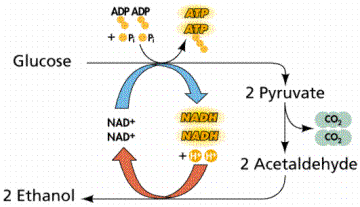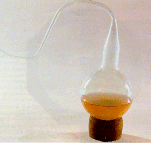Glucose

Ethanol (alcohol)
Fermentation
|
Glucose |
|
Ethanol (alcohol) |
 In 1856 Monsieur Bigo, a distillator from
the North of France presented Pasteur with a problem: the wine in some of his
vats had turned sour. Pasteur noticed that the wine that was not sour
consisted of circular yeast cells that produced ethanol (alcohol) but the sour
vats also contained long, black bacteria that produced lactic acid.
In 1856 Monsieur Bigo, a distillator from
the North of France presented Pasteur with a problem: the wine in some of his
vats had turned sour. Pasteur noticed that the wine that was not sour
consisted of circular yeast cells that produced ethanol (alcohol) but the sour
vats also contained long, black bacteria that produced lactic acid.
After much experimentation, Pasteur resolved Monsieur Bigo's Problems, and had managed to perfect the method of fermentation. He found that by heating a broth of yeast and a little sugar he was able to kill the bacteria and produce wine or beer that was not acidic. During this process carbon dioxide, produced by the yeast must be allowed to leave the system, but at the same time oxygen must be prevented from entering. During fermentation the yeast transforms the glucose found in grape juice to pyruvic acid, this acid is then transformed to ethanol by a method called glycolysis, shown below.

From his findings Pasteur was able to classify microorganisms into two main categories. Aerobic - those that cannot survive without oxygen such as the bacteria that produced lactic acid and anaerobic, that can only live without oxygen like the yeast cells. It is for this reason that oxygen must not enter the system during fermentation.
 As
a result of his research on fermentation Pasteur was able to prove that
microorganisms enter the broth from particles in the atmosphere. He proved
his hypothesis with the help of a swan-necked flask. After sterillisation
the broth was placed in the flask but the particles were prevented form entering
the solution by the moist walls of the flask. On tipping the flask,
however, the sterile contents then became contaminated as they touched the
sides. In 1862 Pasteur was thus able to confirm that germs do not appear
spontaneously but that they appear in the atmosphere and begin to multiply only
when the conditions are favourable.
As
a result of his research on fermentation Pasteur was able to prove that
microorganisms enter the broth from particles in the atmosphere. He proved
his hypothesis with the help of a swan-necked flask. After sterillisation
the broth was placed in the flask but the particles were prevented form entering
the solution by the moist walls of the flask. On tipping the flask,
however, the sterile contents then became contaminated as they touched the
sides. In 1862 Pasteur was thus able to confirm that germs do not appear
spontaneously but that they appear in the atmosphere and begin to multiply only
when the conditions are favourable.
 Following
this research, Pasteur discovered that the method sterillisation, by the
addition of heat lead to the pasturisation of milk - hence its name. He
found that by heating milk at a moderate temperature (about 60 degrees) for
about 15 minutes it was possible to kill the bacteria responsible for turning
milk sour. Several years later it was found that this temperature also
destroyed the bacteria responsible for Scarlet fever, tuberculosis, typhoid and diphtheria
that are found in numerous samples of milk.
Following
this research, Pasteur discovered that the method sterillisation, by the
addition of heat lead to the pasturisation of milk - hence its name. He
found that by heating milk at a moderate temperature (about 60 degrees) for
about 15 minutes it was possible to kill the bacteria responsible for turning
milk sour. Several years later it was found that this temperature also
destroyed the bacteria responsible for Scarlet fever, tuberculosis, typhoid and diphtheria
that are found in numerous samples of milk.